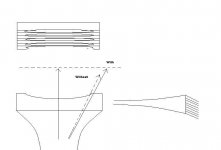http://www.partsexpress.com/pe/showdetl.cfm?DID=7&PartNumber=264-512
Out of curiosity, what exactly is a "Phase lens/shield" and what is it's purpose?
Out of curiosity, what exactly is a "Phase lens/shield" and what is it's purpose?
I think it cancels out or at least shift the direction to the sides , the ultra sonic breakup mode of the tweeter.
I've removed a phase lens from a tweeter before, and it sounds better without it. Namely the tweeter in my B&W CDM1 SE.
I've removed a phase lens from a tweeter before, and it sounds better without it. Namely the tweeter in my B&W CDM1 SE.
Member
Joined 2003
I think in the case of the driver you linked to, it's marketing buzz. They have come up with a fancy name for a speaker guard.
Now, if you are talking about phase plugs, then that's a different story.
Now, if you are talking about phase plugs, then that's a different story.
It blocks radiation from the very tip, which otherwise would combine destructively with the radiation from the edge and cause a high frequency droop.
It also serves admirably to protect the rather thin domes on these tweeters as well. I dented my D25 and then removed the dome and gently massaged out the dent so it is no longer visible, the response is still different from the undamaged tweeter.
It also serves admirably to protect the rather thin domes on these tweeters as well. I dented my D25 and then removed the dome and gently massaged out the dent so it is no longer visible, the response is still different from the undamaged tweeter.
Thanks for the help!
I was thinking about whether or not to remove the phase thingy from my tweeter, and was curious as to how it changes the sound. Any advice?
Here is the tweeter I have:
http://www.partsexpress.com/pe/pshowdetl.cfm?&DID=7&Partnumber=275-055
Probably should've linked to it in the first post...getting lazy I guess
I was thinking about whether or not to remove the phase thingy from my tweeter, and was curious as to how it changes the sound. Any advice?
Here is the tweeter I have:
http://www.partsexpress.com/pe/pshowdetl.cfm?&DID=7&Partnumber=275-055
Probably should've linked to it in the first post...getting lazy I guess

Phase lens
JBL had their 'lens' on the front of the very popular component series of horns from years ago ...some had quite a complex/pretty design, the theory was a particular point source of sound had to travel furthur toward the edges so it traveled a longer path and was so called aligned with a wave that traveled inline with the horn.
JBL called them lenses...attached to the face of their horns.
_____________________________________Rick..............
JBL had their 'lens' on the front of the very popular component series of horns from years ago ...some had quite a complex/pretty design, the theory was a particular point source of sound had to travel furthur toward the edges so it traveled a longer path and was so called aligned with a wave that traveled inline with the horn.
JBL called them lenses...attached to the face of their horns.
_____________________________________Rick..............
Attachments
Taken from http://www.speakerdesign.net/dayton_rs/midrange/rs52/dayton_rs52.htmlHard-domed tweeters, in most cases, include what is called a "phase shield". This is usually in the form of a disc-shaped piece of material supported, in one way or another, directly in front of the dome and centered on it. It's not been used in hard-domed midrange drivers at all, to my knowledge.
There is at times some misunderstanding of just what this shield does. It doesn't alter phase per se, as it cannot alter the phase of the signal as it emerges from the dome. Its purpose is to block the output from the tip of the tweeter, the reason being that at the upper range of tweeters, somewhere around 10KHz and up, the signal emanating from the tip will actually arrive at the listener prior to that sound emanating from the rim, where the former attaches to the diaphragm. At high frequencies the time difference is significant enough that there is a phase delta that causes interference to occur.
The reason that this occurs is because a hard-domed diaphragm is pistonic to a much higher frequency than softer diaphragms. Essentially, the speed of sound is much faster in the hard material than it is in air, it therefore reachs the tip and emanates form it before the sound passing through the air originating from the diaphragm rim area can reach the equivalent distance out from the driver.
Judging from that information, removing it should cause interferance. It might make sense to remove it if you are using a higher order crossover - to counter it's phase shift (ever so slightly, I imagine). But that's something I would not try unless I could measure phase/frq and distortion before and after.
I'm just guessing.
- Status
- Not open for further replies.
- Home
- Loudspeakers
- Multi-Way
- What is a "phase lens"?
